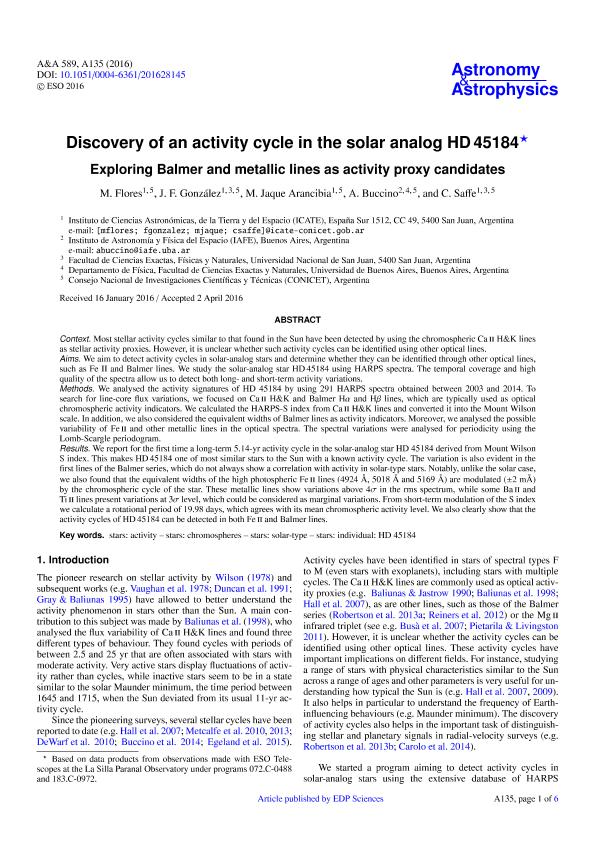Mostrar el registro sencillo del ítem
dc.contributor.author
Flores Trivigno, Matias Gaston

dc.contributor.author
Gonzalez, Jorge Federico

dc.contributor.author
Jaque Arancibia, Marcelo Daniel

dc.contributor.author
Buccino, Andrea Paola

dc.contributor.author
Saffe, Carlos

dc.date.available
2017-08-04T20:04:28Z
dc.date.issued
2016-05
dc.identifier.citation
Flores Trivigno, Matias Gaston; Gonzalez, Jorge Federico; Jaque Arancibia, Marcelo Daniel; Buccino, Andrea Paola; Saffe, Carlos; Discovery of an activity cycle in the solar-analog HD 45184. Exploring Balmer and metallic lines as activity proxy candidates; EDP Sciences; Astronomy and Astrophysics; 589; A135; 5-2016; 1-6
dc.identifier.issn
0004-6361
dc.identifier.uri
http://hdl.handle.net/11336/21901
dc.description.abstract
Context. Most stellar activity cycles similar to that found in the Sun have been detected by using the chromospheric Ca ii H&K lines as stellar activity proxies. However, it is unclear whether such activity cycles can be identified using other optical lines. Aims. We aim to detect activity cycles in solar-analog stars and determine whether they can be identified through other optical lines, such as Fe II and Balmer lines. We study the solar-analog star HD 45184 using HARPS spectra. The temporal coverage and high quality of the spectra allow us to detect both long- and short-term activity variations. Methods. We analysed the activity signatures of HD 45184 by using 291 HARPS spectra obtained between 2003 and 2014. To
search for line-core flux variations, we focused on Ca ii H&K and Balmer Hα and Hβ lines, which are typically used as optical chromospheric activity indicators. We calculated the HARPS-S index from Ca ii H&K lines and converted it into the Mount Wilson scale. In addition, we also considered the equivalent widths of Balmer lines as activity indicators. Moreover, we analysed the possible variability of Fe ii and other metallic lines in the optical spectra. The spectral variations were analysed for periodicity using the Lomb-Scargle periodogram. Results. We report for the first time a long-term 5.14-yr activity cycle in the solar-analog star HD 45184 derived from Mount Wilson S index. This makes HD 45184 one of most similar stars to the Sun with a known activity cycle. The variation is also evident in the first lines of the Balmer series, which do not always show a correlation with activity in solar-type stars. Notably, unlike the solar case, we also found that the equivalent widths of the high photospheric Fe ii lines (4924 Å, 5018 Å and 5169 Å) are modulated (±2 mÅ)
by the chromospheric cycle of the star. These metallic lines show variations above 4σ in the rms spectrum, while some Ba ii and Ti ii lines present variations at 3σ level, which could be considered as marginal variations. From short-term modulation of the S index we calculate a rotational period of 19.98 days, which agrees with its mean chromospheric activity level. We also clearly show that the
activity cycles of HD 45184 can be detected in both Fe ii and Balmer lines.
dc.format
application/pdf
dc.language.iso
eng
dc.publisher
EDP Sciences

dc.rights
info:eu-repo/semantics/openAccess
dc.rights.uri
https://creativecommons.org/licenses/by-nc-sa/2.5/ar/
dc.subject
Stars: Activity
dc.subject
Stars: Chromospheres
dc.subject
Stars: Solar-Type
dc.subject
Stars: Individual: Hd 45184
dc.subject.classification
Astronomía

dc.subject.classification
Ciencias Físicas

dc.subject.classification
CIENCIAS NATURALES Y EXACTAS

dc.title
Discovery of an activity cycle in the solar-analog HD 45184. Exploring Balmer and metallic lines as activity proxy candidates
dc.type
info:eu-repo/semantics/article
dc.type
info:ar-repo/semantics/artículo
dc.type
info:eu-repo/semantics/publishedVersion
dc.date.updated
2017-07-27T12:49:36Z
dc.journal.volume
589
dc.journal.number
A135
dc.journal.pagination
1-6
dc.journal.pais
Francia

dc.journal.ciudad
Paris
dc.description.fil
Fil: Flores Trivigno, Matias Gaston. Consejo Nacional de Investigaciones Científicas y Técnicas. Centro Científico Tecnológico Conicet - San Juan. Instituto de Ciencias Astronómicas, de la Tierra y del Espacio. Universidad Nacional de San Juan. Instituto de Ciencias Astronómicas, de la Tierra y del Espacio; Argentina
dc.description.fil
Fil: Gonzalez, Jorge Federico. Consejo Nacional de Investigaciones Científicas y Técnicas. Centro Científico Tecnológico Conicet - San Juan. Instituto de Ciencias Astronómicas, de la Tierra y del Espacio. Universidad Nacional de San Juan. Instituto de Ciencias Astronómicas, de la Tierra y del Espacio; Argentina
dc.description.fil
Fil: Jaque Arancibia, Marcelo Daniel. Consejo Nacional de Investigaciones Científicas y Técnicas. Centro Científico Tecnológico Conicet - San Juan. Instituto de Ciencias Astronómicas, de la Tierra y del Espacio. Universidad Nacional de San Juan. Instituto de Ciencias Astronómicas, de la Tierra y del Espacio; Argentina
dc.description.fil
Fil: Buccino, Andrea Paola. Consejo Nacional de Investigaciónes Científicas y Técnicas. Oficina de Coordinación Administrativa Ciudad Universitaria. Instituto de Astronomía y Física del Espacio. - Universidad de Buenos Aires. Facultad de Ciencias Exactas y Naturales. Instituto de Astronomía y Física del Espacio; Argentina
dc.description.fil
Fil: Saffe, Carlos. Consejo Nacional de Investigaciones Científicas y Técnicas. Centro Científico Tecnológico Conicet - San Juan. Instituto de Ciencias Astronómicas, de la Tierra y del Espacio. Universidad Nacional de San Juan. Instituto de Ciencias Astronómicas, de la Tierra y del Espacio; Argentina
dc.journal.title
Astronomy and Astrophysics

dc.relation.alternativeid
info:eu-repo/semantics/altIdentifier/doi/http://dx.doi.org/10.1051/0004-6361/201628145
dc.relation.alternativeid
info:eu-repo/semantics/altIdentifier/url/https://www.aanda.org/articles/aa/abs/2016/05/aa28145-16/aa28145-16.html
dc.relation.alternativeid
info:eu-repo/semantics/altIdentifier/url/https://arxiv.org/abs/1604.01307
Archivos asociados
